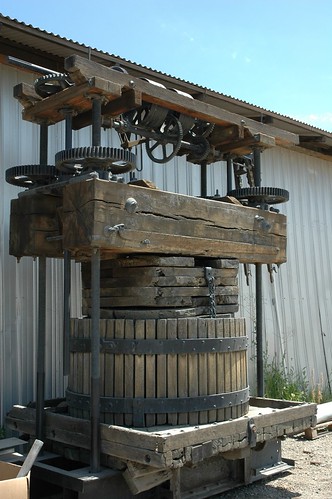 we were hoping for. I made a notebook of these Southbay Wineries. or you can buy my source, The Best of the Wine Country. WARNING: The following contains extreme yuppyism, for I am about to discuss wine. Please resist the urge to punch me in the face after reading this to restore your street cred.
we were hoping for. I made a notebook of these Southbay Wineries. or you can buy my source, The Best of the Wine Country. WARNING: The following contains extreme yuppyism, for I am about to discuss wine. Please resist the urge to punch me in the face after reading this to restore your street cred.Retzlaff Winery
Because of it's small size and smooth wines, this was a good place to start. When we arrived, the hostess was the only person in the tasting room. After tasting a few wines, I readily admitted that we were fairly new to the wine tasting circuit. This started a pattern that would repeat itself for the rest of the day: the hostess completely opened up, took us on a tour of the aging rooms, and let us sample different vintages, from the casks, for free. It was a great to see the evolution of the wine, starting with an '06 recently picked, to a dark '01. The thing that surprised me most was how much the wine changes in the first year ('06 compared to the '05). It was another example of the last 10% improvement costing the most.
Neither S nor I like Chardonnay, but the version here was very clean and didn't have the dry oaky flavor that normally turns me away. The reds were also clean; too clean actually. I prefer the bolder wines we found later that day.
Concannon Vinyard
Quite a contrast to Retzalff, Concannon had a large storehouse and tasting room. The medium sized parking lot was full, so we were looking forward to a different experience. President's Day weekend the winery opened its reserve wines for tasting, pouring them at different stations complemented by cheese or chocolate. Again I started asking newbie questions at one of the later stages and struck up a conversation with the folks behind the table. Before I knew what was happening, S and I were whisked away and had started a private tour of the winery.

We started outside, looking at the hoppers which separate the grapes from the stems and leaves. Taken through the distillers, mixers, and filters we asked questions and got to poke our heads into some of the empty steel containers. Andrew, our host, gave us a few lessons on how they buy, care for, and use the wine casks. The above picture is one of the original grape presses that was used by the founder, James Concannon.
Jim Concannon is the grandson, and now runs the vineyard. We met him in the storage room, where the casked wine was held at a constant 54 degrees. Jim told us about climbing around the old room when he was young, pointed out the grooves in the floor where the draft horses used to haul full casks in or press grapes, and explained that the winery was only able to stay open during the prohibition thanks to the communion wine needed by the local churches.
Petite Syrah is the Concannon specialty. For me, though, this wine ended very abruptly. The "full" Syrah was more enjoyable and the Merlot was excellent: very bold. They had a new-to-me Spanish style wine, Contenello (?), that was nice and spicy. The whites were disappointing.
Crooked Vine
Crooked had an enlightening barrel tasting scheme: there were three casks, two different types of grapes, and two different types of wood. I was surprised that the type of wood, French Oak versus American, had already altered the taste of the wine. These casks were also '06 wines, so they hadn't been aging long. We talked with the hostess about the job of the head winemaker: how do they know when a wine is done? What are they looking for? How do they blend? The answer to all the questions is basically "whatever feels right to him/her." This drove the personalization of the wine home for me: with so many ways for a grape to interact with its soil and environment, the resulting juice to interact with its cask, the resulting wine to be tweaked and aged by a wine expect, and the end product to interact with the taster, no wonder there are so many variations.
I highly recommend a trip to this area, and you'll be reading about my next one.



